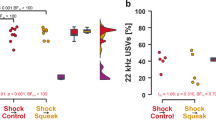Abstract
The “archival” (refereed journal or invited review) literature almost uniformly indicates that, consistent with most currently popular theories of behavior, rats prefer signaled shocks even when those shocks are un-modifiable. However, the experiments reported in this literature are here examined on the basis of technical-apparatus (instrumentation) and experimental-design (methodological) soundness. With regard to the assessment of instrumentation problems, it was found that a type of modified Skinner box used in preparations reporting strong preference for signaled shock was subject to significant unauthorized modification of shock intensity, attributable in part to the geometry of the shock grid with respect to nonconducting surfaces. Methodological analysis of the structure of the experimental design, associated with evidence in the modified Skinner box, showed that this design is invalid logically as a preference index, because of asymmetrical factors in the behaviors associated with preference and in the consequences arising from these behaviors.
Similar content being viewed by others
References
ARABIAN, D. M., & DESIDERATO, O. 1975. Preference for signaled shock: a test of two hypotheses. Animal Learning and Behavior, 3, 191–195.
AVERILL, J. R., & ROSENN, M. 1972. Vigilant and nonvigilant coping strategies and psychophysiological stress reactions during the anticipation of electric shock. Journal of Personality and Social Psychology, 23, 128–141.
AZRIN, N. H. 1959. A technique for delivering shock to pigeons. Journal of the Experimental Analysis of Behavior, 2, 161–163.
BADIA, P., COKER, C. C., & HARSH, J. 1973. Choice of higher density signaled shock over lower density unsignaled shock. Journal of the Experimental Analysis of Behavior, 20, 47–55.
BADIA, P., & CULBERTSON, S. 1972. The relative aversiveness of signaled vs. unsignaled escapable and inescapable shock. Journal of the Experimental Analysis of Behavior, 17, 463–471.
BADIA, P., CULBERTSON, S., & HARSH, J. 1973. Choice of longer or stronger signaled shock over shorter or weaker unsignaled shock. Journal of the Experimental Analysis of Behavior, 19, 25–32.
BERLYNE, D. E. 1960. Conflict, arousal, and curiosity. New York: McGraw-Hill.
BIEDERMAN, G. B., & FUREDY, J. J. 1970. The preference-for-signaled-shock phenomenon: signaling shock is reinforcing only if shock is modifiable. Quarterly Journal of Experimental Psychology, 22, 681–685.
BIEDERMAN, G. B., & FUREDY, J. J. 1973. Preference-for-signaled-shock phenomenon: effects of shock modifiability and light reinforcement. Journal of Experimental Psychology, 100, 380–386.
BIEDERMAN, G. B., & FUREDY, J. J. 1976. Operational duplication without behavioral replication of changeover for signaled inescapable shock. Bulletin of the Psychonomic Society, 7, 421–424.
D’AMATO, M. R. 1974. Derived motives. Annual Review of Psychology, 25, 83–106.
FUREDY, J. J. 1975. An integrative progress report on informational control in humans: Some laboratory findings and methodological claims. Australian Journal of Psychology, 27, 61–83.
FUREDY, J. J., & BIEDERMAN, G. B. 1976. Preference-for-signaled-shock phenomenon; Direct and indirect evidence for modifiability factors in the shuttle-box. Animal Learning and Behavior, 4, 1–5.
FUREDY, J. J., & DOOB, A. N. 1971. Autonomic responses and verbal reports in further tests of the preparatory-adaptive-response interpretation of reinforcement. Journal of Experimental Psychology, 89, 258–264.
FUREDY, J. J., & DOOB, A. N. 1972. Signaling unmodifiable shocks: limits on human informational cognitive control. Journal of Personality and Social Psychology, 21, 111–115.
IRWIN, F. W. 1958. An analysis of the concepts of discrimination and preference. American Journal of Psychology, 71, 152–163.
LOCKARD, J. S. 1963. Choice of a warning signal or no warning signal in an unavoidable shock situation. Journal of Comparative and Physiological Psychology, 3, 526–530.
LOCKARD, J. S. 1965. Choice of a warning signal or none in several unavoidable-shock situations. Psychonomic Science, 3, 5–6.
LOHR, T. F. 1959. The effect of shock on the rat’s choice of a path to food. Journal of Experimental Psychology, 58, 312–318.
MILLER, R. R., DANIEL, D., & BERK, A. M. 1974. Successive reversals of a discriminated preference for signaled tailshock. Animal Learning and Behavior, 2, 271–274.
MUENZINGER, K. F., BROWN, W. O., CROW, W. J., & POWLOSKI, R. F. 1952. Motivation in learning: XI. An analysis of electric shock for correct responses into avoidance and accelerating components. Journal of Experimental Psychology, 43, 115–119.
MUENZINGER, K. F., & POWLOSKI, R. F. 1951. Motivation in learning: X. Comparison of electric shock for correct turns in a corrective and non-corrective situation. Journal of Experimental Psychology, 42, 118–124.
PERKINS, C. C., Jr. 1968. An analysis of the concept of reinforcement. Psychological Review, 75, 155–172.
PERKINS, C. C., Jr., LEVIS, D. J., & SEYMANN, R. G. 1963. Preference for signal-shock vs. shock-signal. Psychological Reports, 13, 735–738.
PERKINS, C. C. Jr., SEYMANN, R. G., LEVIS, D. J., & SPENCER, H. R., Jr. 1966. Factors affecting preference for signal-shock over shock-signal. Journal of Experimental Psychology, 72, 190–196.
SANDLER, J., & DAVIDSON, R. S. 1967. Punished behavior in the presence of a non-punished alternative. Psychonomic Science, 8, 297–298.
SELIGMAN, M. E. P. 1975. Helplessness. San Francisco: Freeman.
STRETCH, R., ORLOFF, G. R., & DALRYMPLE, S. D. 1968. Maintenance of responding by fixed-interval schedule of electric shock presentation in squirrel monkeys. Science, 162, 583–586.
Author information
Authors and Affiliations
Additional information
This research was supported by grants from the National Research Council of Canada and University of Toronto Health Science Committee. We are grateful to G. A. Heighington for expert technical assistance.
Rights and permissions
About this article
Cite this article
Biederman, G.B., Furedy, J.J. Preference for Signaled Shock in Rats? Instrumentation and Methodological Errors in the Archival Literature. Psychol Rec 26, 501–514 (1976). https://doi.org/10.1007/BF03394416
Published:
Issue Date:
DOI: https://doi.org/10.1007/BF03394416




